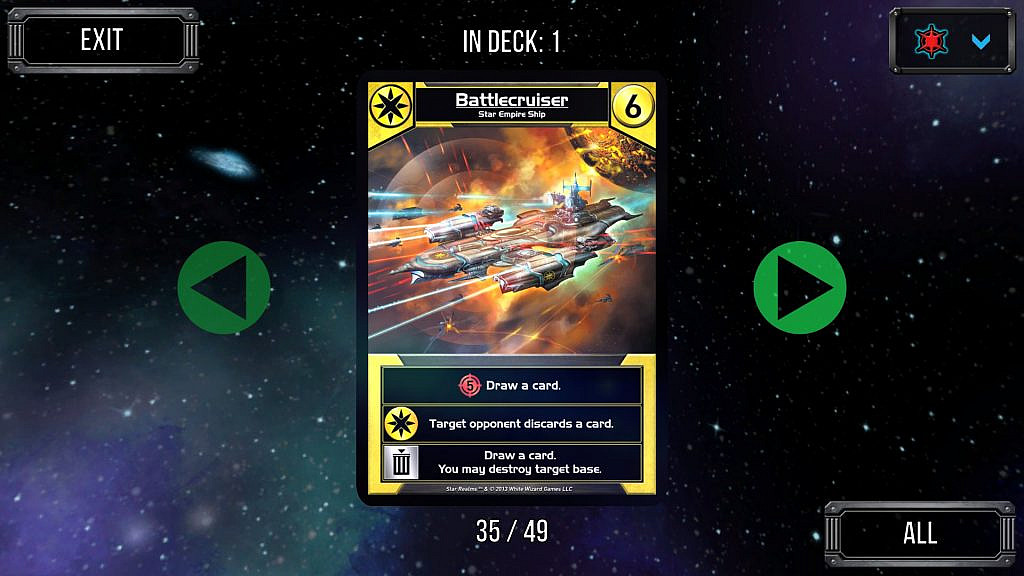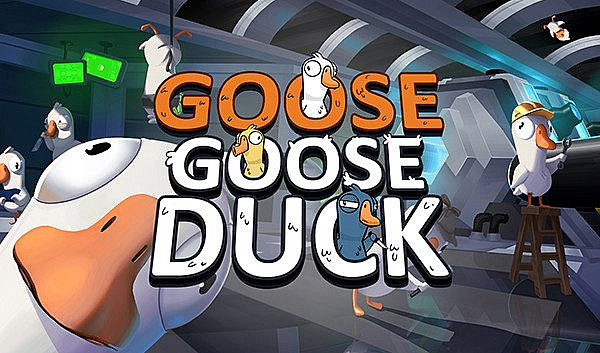Star Realms is a deck-building card game where players buy and use ships and bases to reduce their opponent’s Authority (or health) to zero. The game is originally physical, but also has digital versions for computer and mobile devices. There are many expansions available that introduce a large number of cards, but I have only played the original version physically and digitally. The two versions play the same, except for some handy automation of actions that is present in the digital version.
Each turn, a player draws five instantly usable cards from their personal deck. There are two card types: ship cards only activate that turn before moving into the discard pile, but base cards stay on the field until they are destroyed by the opponent. In the middle of the board, there is the Trade Row, offering cards that both players can buy and add to their deck during their turn. Once one has been bought, another random card replaces it, so there are always five options available. When a player’s personal deck is out of cards, the discard pile is shuffled into a new deck to draw from.

Here, the player has two permanent bases (lower left) and three temporary ships. They have one trade point and three combat points that they can use.
The first turns are quite slow, as the player can only play their basic Scout and Viper cards, which either generate money or attack the enemy. The interesting part is the selection of new cards from the Trade Row, which is how the player builds their deck. Cards can have strong abilities, which usually means they are also expensive and require many trade points to obtain.
Abilities and effects are the most important part of the game. Getting rid of weak starting cards from the deck permanently by “scrapping” them with Scrap Abilities increases the odds of drawing acquired stronger cards in the future. Outposts are especially important bases with their own health points that protect the player from taking Authority damage as long as they are on the board, and buying these is important for survival.
There are four factions, and most cards belong to one of these. They have a focus on different playstyles: for example, the Machine Cult likes to scrap cards from their deck’s rotation and the Trade Federation heals Authority the most. The faction abilities that activate when there are multiple cards of the same faction on the same side can be extremely strong, such as acquiring a card from the Trade Row for free or destroying an enemy base outright. Focusing on one or two factions is recommended to increase the odds of activating faction abilities. Keeping track of what faction the opponent uses and destroying those cards from the Trade row pre-emptively is an advanced strategy that is also possible with abilities.

The card art is fantastic regardless of faction, and I especially enjoy the colors. Cards don’t have too much information, so evaluating them is easy.
Playing aggressively has been the most efficient strategy in the games I have played. Focusing on cards that attack can end the game rather quickly, and the damage soon adds up so that no amount of defenses and healing can save the defending player. I feel this (lack of) balance is actually a good thing, as it ensures that games do not last too long. The games I have played have always taken under 30 minutes, which is suitable for the game’s light approach.
In my opinion, there is just enough depth and strategy for the game to be addicting while remaining approachable. This is the first game I have played in the deck-building genre, and it has made me interested to try others like it. Learning the rules has been fast, but each round is different and enjoyable. The card designs and factions create a likable environment around the game that fans of science fiction can appreciate. Overall, this is a card game that is easy to recommend.
Designer: Robert Dougherty, Darwin Kastle
Publisher: Wise Wizard Games
Release date: 2014
Number of players: 2
Playing time: 20 min
Ages: 12+
Featured image from the official site, https://www.starrealms.com/sets-and-expansions/
Screenshots from the digital version of the game, taken by the author.
You might also like
More from Game Reviews
Mining, Mayhem, and Bugs: A Deep Rock Galactic Review
Fight monsters, mine riches, and cause chaos with your dwarf crew — welcome to Deep Rock Galactic!
Microsoft Solitaire: classic games to kill time
Perhaps the most played games in offices worldwide, Microsoft Simulator is a pinacle of design from the era where games …
Reviewing Elden Ring amidst Elden Ring Nightreign hype
Elden Ring Nightreign is coming soon, so now might be a great time to take a another look at Elden …















